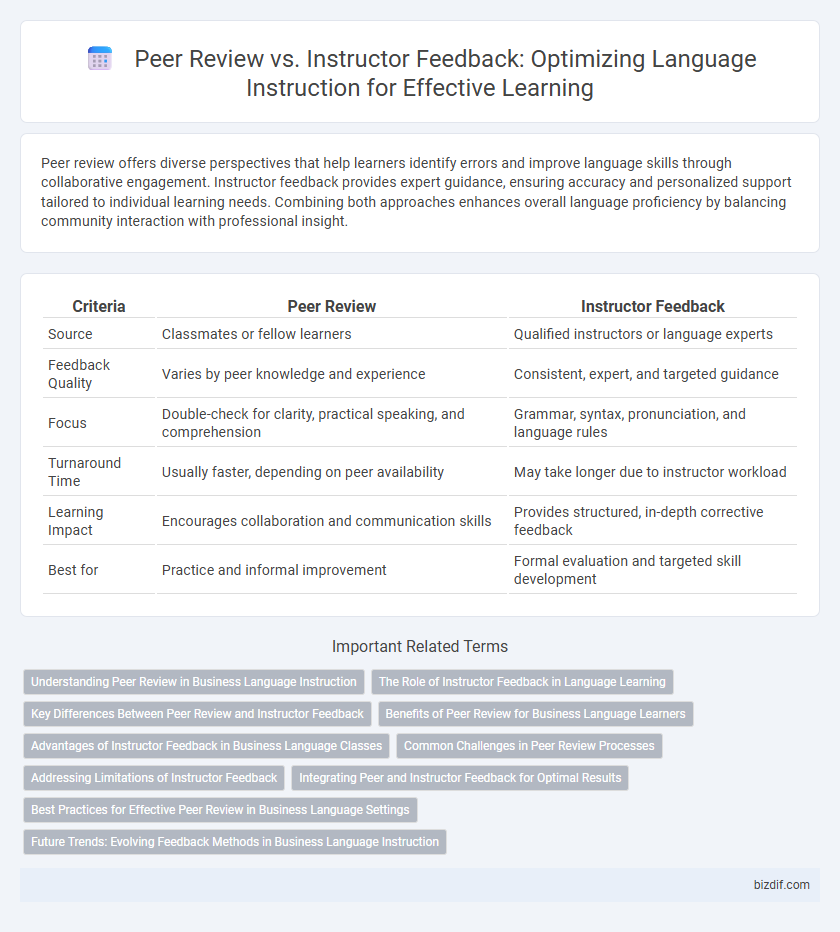Peer review offers diverse perspectives that help learners identify errors and improve language skills through collaborative engagement. Instructor feedback provides expert guidance, ensuring accuracy and personalized support tailored to individual learning needs. Combining both approaches enhances overall language proficiency by balancing community interaction with professional insight.
Table of Comparison
| Criteria | Peer Review | Instructor Feedback |
|---|---|---|
| Source | Classmates or fellow learners | Qualified instructors or language experts |
| Feedback Quality | Varies by peer knowledge and experience | Consistent, expert, and targeted guidance |
| Focus | Double-check for clarity, practical speaking, and comprehension | Grammar, syntax, pronunciation, and language rules |
| Turnaround Time | Usually faster, depending on peer availability | May take longer due to instructor workload |
| Learning Impact | Encourages collaboration and communication skills | Provides structured, in-depth corrective feedback |
| Best for | Practice and informal improvement | Formal evaluation and targeted skill development |
Understanding Peer Review in Business Language Instruction
Peer review in business language instruction fosters collaborative learning by allowing students to evaluate each other's communication skills, promoting critical thinking and real-world application. This method enhances understanding of professional terminology and context through diverse perspectives, which can often be more relatable than instructor-centric feedback. Peer review also develops interpersonal skills essential for business environments, such as constructive criticism and teamwork, complementing instructor feedback by creating a dynamic, interactive learning experience.
The Role of Instructor Feedback in Language Learning
Instructor feedback plays a crucial role in language learning by providing personalized, accurate corrections that address individual learner errors and promote targeted skill development. This expert guidance helps students internalize language rules, improve pronunciation, grammar, and writing, and fosters deeper understanding than peer review alone. Research indicates that informed instructor feedback accelerates language acquisition by clarifying complex concepts and motivating learners through constructive, actionable insights.
Key Differences Between Peer Review and Instructor Feedback
Peer review emphasizes collaborative learning, allowing students to engage with diverse perspectives and develop critical thinking by evaluating peers' work. Instructor feedback provides expert guidance with a focus on accuracy, content mastery, and adherence to academic standards, ensuring personalized and authoritative assessment. Differences lie in source credibility, feedback specificity, and impact on learner autonomy, influencing language acquisition and skill improvement.
Benefits of Peer Review for Business Language Learners
Peer review fosters collaborative learning by enabling business language learners to exchange constructive critiques, which enhances communication skills and cultural understanding. This interactive process promotes critical thinking and increases engagement, making language acquisition more practical and applicable in real-world business scenarios. Peer feedback also accelerates improvement by providing diverse perspectives that complement instructor guidance.
Advantages of Instructor Feedback in Business Language Classes
Instructor feedback in business language classes offers precise guidance tailored to professional communication standards, ensuring learners master industry-specific terminology and etiquette. It provides authoritative evaluation of language accuracy, fluency, and appropriate tone, which is crucial for effective interaction in corporate environments. Personalized feedback helps address individual weaknesses and accelerates skill acquisition, leading to improved confidence in real-world business scenarios.
Common Challenges in Peer Review Processes
Common challenges in peer review processes include varying levels of reviewer expertise, which can affect the quality and accuracy of feedback. Students often struggle with giving constructive criticism due to limited training in evaluation skills, leading to vague or unhelpful comments. Managing time constraints and ensuring consistent participation further complicate the effectiveness of peer review in language instruction.
Addressing Limitations of Instructor Feedback
Peer review enhances language instruction by providing diverse perspectives that address limitations of instructor feedback, such as limited availability and potential biases. It encourages collaborative learning, enabling students to engage critically with language use and receive immediate, varied input. This complementary approach fosters more comprehensive skill development through continuous, peer-driven evaluation.
Integrating Peer and Instructor Feedback for Optimal Results
Integrating peer review and instructor feedback enhances language instruction by combining diverse perspectives with expert guidance, fostering a comprehensive learning experience. Peer feedback promotes collaborative skills and critical thinking, while instructor input ensures accuracy and addresses specific linguistic challenges. This dual approach leads to improved language proficiency, greater learner autonomy, and more targeted skill development.
Best Practices for Effective Peer Review in Business Language Settings
Effective peer review in business language settings involves providing constructive, specific, and actionable feedback that focuses on clarity, tone, and professional vocabulary. Establishing clear criteria and rubrics ensures consistent evaluations and enhances accountability among peers. Encouraging a respectful, collaborative environment fosters confidence and promotes continuous improvement in business communication skills.
Future Trends: Evolving Feedback Methods in Business Language Instruction
Emerging trends in business language instruction emphasize AI-driven peer review platforms that provide real-time, personalized feedback, enhancing learner engagement and accuracy. Instructors increasingly utilize data analytics to tailor feedback, integrating both automated assessments and human insights for comprehensive skill development. Hybrid approaches combining peer collaboration with instructor oversight leverage technology to foster continuous, adaptive learning environments.
Peer Review vs Instructor Feedback Infographic

 bizdif.com
bizdif.com